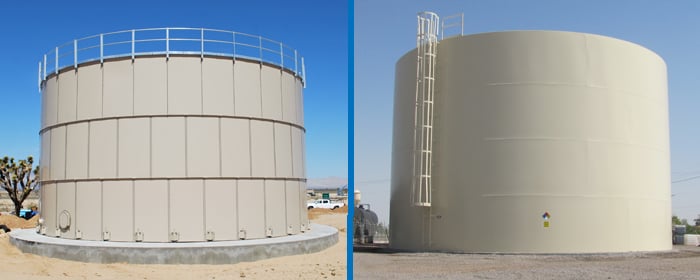
Water storage tanks for fire protection has improved in recent years as technology has advanced, processes have evolved and standards have become more rigorous resulting in increased flexibility, greater durability and lower costs.
Modern ground storage tanks used for fire protection are commonly one of three designs; bolted steel tanks, welded steel tanks and concrete tanks. Concrete tanks are commonly used for projects requiring greater than 80,000 gallons of water storage due to the high set up cost of the required equipment on the job site. This expense makes smaller concrete tanks cost prohibitive relative to other designs. Welded steel tanks for fire protection provide a wider range of capacities anywhere between 25,000 to 3,500,000 gallons. In addition, welded steel tanks are available in a variety of configurations including reservoir style storage tanks and standpipe water tanks. For certain applications, customers prefer the smooth exterior of a welded steel storage tank.
Of the three types of ground storage tanks, bolted steel tanks provides the greatest flexibility, outstanding longevity and best cost efficiency. Bolted tanks provide the larger range of sizes, from 5,000 to 3,500,000 gallons. For most fire protection projects, the storage tanks required range in capacity from 25,000 to 250,000 gallons which is well suited for a bolted steel tank. Bolted steel tanks are frequently used within existing infrastructure to increase water storage or to provide storage in remote areas. For example, when a new warehouse is built and requires water for fire protection, a new bolted steel tank can easily be installed on site, even in areas with constrained space. Alternatively, bolted tanks work well for remote areas and are available in either closed-top or open-top “scoop tank” design.
Bolted steel storage tanks are precision fabricated in State of the Art factories and complete kits are delivered to the jobsite ready to install. Technological advances in the tank manufacturing process, quality of raw materials and design standards have improved the durability of bolted steel tanks. Equipment used to produce bolted tanks commonly includes CNC machinery, turret punch presses and hydraulic press brakes to ensure tank components meet exact specifications to make assembly at the job site hassle free and to prevent leaks. Heavy duty, synthetic rubber gaskets fabricated of heavy duty EPDM, Viton or Buna-N are used to provide decades of maintenance free service and durable epoxy powder coating provides outstanding protection against corrosion. Bolted tanks with factory powder coating differ from glass lined bolted steel tanks as glass lined tanks cannot be repaired if coating damage occurs. Conversely, epoxy coated steel tanks can be repaired and therefore the overall lifespan of a powder coated tank is significantly increased compared to glass fused to steel tanks.
The ability to finish bolted steel tanks in the factory eliminates the need to sandblast and paint tanks in the field which is required with welded steel tanks. By eliminating these processes, the noise, dust and traffic at the job site is dramatically reduced, making bolted tanks the perfect solution for installation within existing infrastructure and sensitive areas. In addition, the risk of fire is dramatically reduced with a bolted steel tank as welding, grinding and other hot work is not required.
To ensure bolted steel tanks perform as intended, modern tanks for fire protection are designed to the specific application and are governed by the National Fire Protection Association (NFPA) code under Section 22. The appurtenances required and size of the tank is determined by amount of water required based on fire suppression calculations. In addition to NFPA 22 requirements, bolted steel tanks can meet the requirements for FM Approvals related to fire protection standards. When potable water storage is also required epoxy coated bolted tanks are designed to American Water Works Association (AWWA) D103 standards. By combining potable water storage with fire protection requirements, two separate tanks can be combined into one larger tank for greater efficiency.
In addition to increased flexibility, longevity and precision, bolted tanks have proven to be a more cost effective solution for fire protection tanks. As only minimal work is required on the job site, bolted steel tanks are more affordable compared to other storage tanks of the same size. Most of the fabrication of a bolted steel tank is performed by precision machinery in the factory and therefore the amount of labor required is very low, reducing manufacturing costs. The increased precision of bolted tank production reduces rework costs and wasted materials. As customers are discovering, a bolted steel tank can provide the perfect solution for both potable water storage as well as storage of water for fire protection.


